Click on images to enlarge

large infestation (Photo: Sheldon Navie)
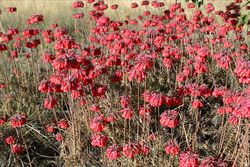
dense infestation (Photo: Sheldon Navie)
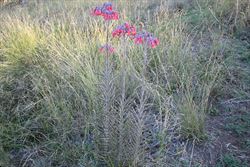
habit (Photo: Sheldon Navie)
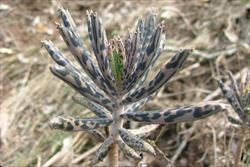
the variegated cylindrical leaves (Photo: Sheldon Navie)

close-up of leaves showing groove and apical notches (Photo: Sheldon Navie)

older leaves with plantlets (Photo: Sheldon Navie)
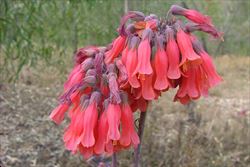
flower clusters (Photo: Sheldon Navie)
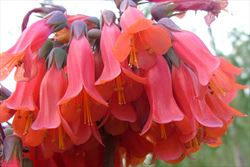
close-up of drooping flowers (Photo: Sheldon Navie)

old flower cluster (Photo: Sheldon Navie)
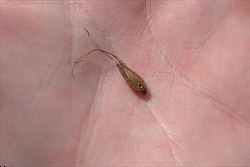
close-up of mature fruit (Photo: Sheldon Navie)

young seedling (Photo: Sheldon Navie)

young plants (Photo: Sheldon Navie)
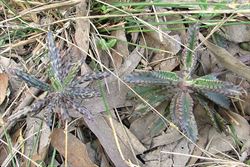
comparison of young mother-of-millions (Bryophyllum delagoense ) plant, on the left, and young hybrid mother-of-millions (Bryophyllum x houghtonii) plant, on the right (Photo: Sheldon Navie)
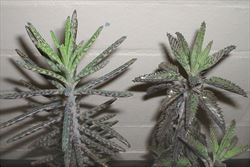
comparison of the almost cylindrical leaves of mother-of-millions (Bryophyllum delagoense), on the left, and the boat-shaped leaves of hybrid mother-of-millions (Bryophyllum x houghtonii), on the right (Photo: Sheldon Navie)

small infestation along an urban footpath in Brisbane (Photo: Sheldon Navie)

habit prior to flowering (Photo: Sheldon Navie)
Scientific Name
Bryophyllum delagoense (Eckl. & Zeyh.) Schinz
Synonyms
Bryophyllum tubiflorum Harv.Bryophyllum verticillatum (Scott-Elliot) BergerKalanchoe delagoensis Eckl. & Zeyh.Kalanchoe tubiflora (Harv.) Raym.-HametKalanchoe verticillata Scott-Elliot
Family
Crassulaceae
Common Names
chandelier plant, Christmas bells, common mother of millions, frogs' legs, mission bells, mother of millions, mother-of-millions, pregnant plant
Origin
Native to Madagascar.
Cultivation
Mother-of-millions (Bryophyllum delagoense) has been widely cultivated as a garden ornamental in Australia, and it can still be commonly seen growing in older gardens.
Naturalised Distribution
A widely distributed species that is mainly naturalised in the eastern parts of Australia. It is most common in the coastal and sub-coastal regions of Queensland and northern New South Wales. Also present in the inland regions of these states, along the central and southern coasts of New South Wales, in coastal Western Australia, in inland South Australia, in Victoria and on Norfolk Island.
Naturalised overseas in southern and eastern Africa, in parts of South America (e.g. Ecuador), in south-eastern USA (i.e. Florida and Texas), on some Pacific islands (i.e. Hawaii and New Caledonia) and in the Mascarenes (i.e. La Réunion).
Habitat
A widespread weed of pastures, grasslands, open woodlands, waste areas, disturbed sites, fencelines, roadsides, embankments, and railways in sub-tropical, semi-arid, tropical and warmer temperate regions. It is commonly found growing in rocky sites or on poor soils.
Habit
A long-lived (i.e. perennial) fleshy (i.e. succulent) plant with upright (i.e. erect) stems usually growing 30-180 cm tall, but occasionally reaching up to 2.5 m or more in height.
Distinguishing Features
- a fleshy herbaceous plant with upright stems growing 30-180 cm tall.
- its mottled leaves are cylindrical and have a few small 'teeth' near their tips.
- tiny plantlets are often produced at the tips of its leaves.
- its drooping bell-shaped flowers (2-4 cm long) are usually red or reddish-pink in colour.
- these flowers are borne in dense clusters at the top of its stems.
Stems and Leaves
The stems are hairless (i.e. glabrous), mostly unbranched, and greyish or pinkish-grey in colour.
The greyish coloured leaves are fleshy (i.e. succulent) in nature (15-150 mm long and 2-6 mm wide) and almost cylindrical (i.e. terete), but with a small lengthwise (i.e. longitudinal) groove. There are several (3-9) 'teeth' located at or near the tip of each leaf (i.e. apical notches). The leaves, and sometimes also the stems, have a darker mottling (i.e. they are variegated) and tiny plantlets form in the 'teeth' at the leaf tips (i.e. in the apical notches).
Flowers and Fruit
The bell-shaped (i.e. tubular) flowers (2-4 cm long) are either red, orange-red or pinkish-red in colour and the four petals are fused for most of their length (i.e. into a corolla tube). They are drooping (i.e. pendulous) and grouped into tightly branched clusters (10-20 cm wide) at the top of the stems (i.e. in terminal corymbose inflorescences). These flowers also have four partially fused greyish coloured sepals (5-13 mm long), a four-lobed ovary, four styles and eight stamens. They are borne on individual stalks (i.e. pedicels) 5-20 mm long. Flowering occurs mainly during winter and early spring.
The dry, papery fruit is a 'follicle' (about 10 mm long) and remains enclosed in the old flower parts. It is deeply-divided into four sections (i.e. carpels) and contains numerous minute brown-coloured seeds (less than 1 mm long).
Reproduction and Dispersal
Mother-of-millions (Bryophyllum delagoense) reproduces by seed and by tiny plantlets that are produced at the tips of its fleshy (i.e. succulent) leaves. Dislodged leaves and broken leaf parts can also take root and give rise to new plants.
This species is commonly spread in dumped garden waste. Its very fine seeds are probably wind and water dispersed and its leaves and plantlets may also be dislodged and spread by animals, vehicles, machinery and slashers.
Environmental Impact
Mother-of-millions (Bryophyllum delagoense) is regarded as a significant environmental weed in Queensland and New South Wales, a minor environmental weed in Western Australia, and a potential environmental the Northern Territory. It is probably of most concern in southern and central Queensland, and was recently ranked as the third most important environmental weed in south-eastern Queensland. It is actively managed by community groups in Queensland and is listed as a priority environmental weed in eight Natural Resource Management regions throughout eastern Australia. In New South Wales it is currently of concern in coastal districts and in inland regions in the north of the state.
This species is well adapted to dry environments and able to survive droughts. It forms very large infestations in grasslands and open woodlands in inland regions and spreads down river systems during flood events. In inland central Queensland, near Dingo, mother-of-millions (Bryophyllum delagoense) is competing with and replacing the native herbs that make up the diet of the endangered nail-tailed wallaby (Onychogalea fraenata). At Mungle Creek, in northern New South Wales, it has invaded a flora reserve and is interfering with the regeneration of remnant stands of brigalow (Acacia harpophylla), and near Childers, in inland southern Queensland, it is one of four invasive plant species that is impacting on the endangered Isis tamarind (Alectryon ramiflorus ).
It is also very invasive in sandy coastal sites (i.e. on foredunes and islands) and was listed as one of three invasive species that were modifying the vegetation structure on Lady Elliott Island in northern Queensland. Mother-of-millions (Bryophyllum delagoense) was also found to be one of the twelve most invasive ornamental species on the fore dunes of the Sunshine Coast in southern Queensland. Mother-of-millions (Bryophyllum delagoense) is also regarded as a potentially serious weed threat to the Abrolhos Islands, which are located off the coast of Geraldton in Western Australia.
Other Impacts
Mother-of-millions (Bryophyllum delagoense) is very poisonous to livestock and humans. Cattle deaths resulting from ingestion of this species are quite common, particularly in south-eastern Queensland. This species commonly invades rangelands and pastures, replacing grasses and legumes, and can significantly reduce the productivity of these areas.
Legislation
This species is declared under legislation in the following states and territories:
- Queensland: Class 2 - landowners must take all reasonable steps to keep land free of this species (throughout the entire state). It is also illegal to sell a declared plant or its seed in this state.
- New South Wales: Class 3 - a regionally controlled weed. The relevant local control authority must be promptly notified of the presence of this weed and it must be fully and continuously suppressed and destroyed (Baulkham Hills, Blacktown, Cessnock, Clarence Valley, Dungog, Gloucester, Great Lakes, Greater Taree, Hawkesbury, Kempsey, Muswellbrook, Penrith, Port Macquarie-Hastings, Singleton and Upper Hunter local authority areas), and Class 4 - a locally controlled weed. The growth and spread of this species must be controlled according to the measures specified in a management plan published by the local control authority and the plant may not be sold, propagated or knowingly distributed (in the Campbelltown, Gosford, Gunnedah, Gwydir, Inverell, Lake Macquarie, Liverpool Plains, Moree Plains, Narrabri, Newcastle, Port Stephens, Tamworth, Tenterfield and Wyong local authority areas).
- Western Australia: Unassessed - this species is declared in other states or territories and is prohibited until assessed via a weed risk assessment (throughout the entire state).
Management
For information on the management of this species see the following resources:
- the Biosecurity Queensland Fact Sheet on mother of millions (Bryophyllum spp.), which is available online at http://www.dpi.qld.gov.au.
- the New South Wales Department of Primary Industries Primefact on mother of millions (Bryophyllum delagoense), which is available online at http://www.dpi.nsw.gov.au.
Similar Species
Mother-of-millions (Bryophyllum delagoense) is very similar to hybrid mother-of-millions (Bryophyllum x houghtonii) and mother-of-thousands (Bryophyllum daigremontianum). It is also relatively similar to resurrection plant (Bryophyllum pinnatum), prolific mother-of-millions (Bryophyllum proliferum) and lavender scallops (Bryophyllum fedtschenkoi). These species can be distinguished by the following differences:
- mother-of-millions (Bryophyllum delagoense) has relatively small cylindrical (i.e. terete) leaves (usually less than 10 cm long and only 2-6 mm wide) that are always simple. These leaves are greyish in colour with some darker patches (i.e. they are variegated) and have a few teeth at their tips (i.e. apical notches).
- hybrid mother-of-millions ( Bryophyllum x houghtonii) has relatively small boat-shaped or folded leaves (4-8 cm long and 8-20 mm wide) that are always simple. These leaves are greyish or greyish-green in colour with some darker patches (i.e. they are variegated) and have numerous teeth along their margins (i.e. marginal notches).
- mother-of-thousands (Bryophyllum daigremontianum) has relatively large boat-shaped or folded leaves (often more than 10 cm long and 25 mm wide) that are always simple. These leaves are greyish-green in colour with some darker patches (i.e. they are variegated) and have numerous teeth along their margins (i.e. marginal notches).
- resurrection plant (Bryophyllum pinnatum) has large, broad, flattened, leaves (5-25 cm long and 20-125 mm wide) that are often compound (i.e. trifoliate or pinnate). These leaves are usually bright green or light green in colour have numerous blunt teeth along their margins (i.e. they are crenate).
- prolific mother-of-millions (Bryophyllum proliferum) has relatively large compound (i.e. pinnate) leaves with 7-11 leaflets (7-5-15 cm long and about 3.5 cm wide). These greenish-coloured leaflets are somewhat elongated in shape, flattened, and have numerous blunt teeth along their margins (i.e. they are crenate).
- lavender scallops (Bryophyllum fedtschenkoi) has small, broad, flattened, leaves (12-50 mm long and 8-25 mm wide) that are always simple. These leaves are usually bluish-green or purplish-green in colour and have numerous reddish-brown coloured blunt teeth along their margins (i.e. they are crenate).
Cotyledon (Cotyledon orbiculata) is also relatively similar to mother of millions (Bryophyllum delagoense). However, this species can be distinguished by its much broader, green or greyish, leaves that usually have a reddish-coloured margin.

